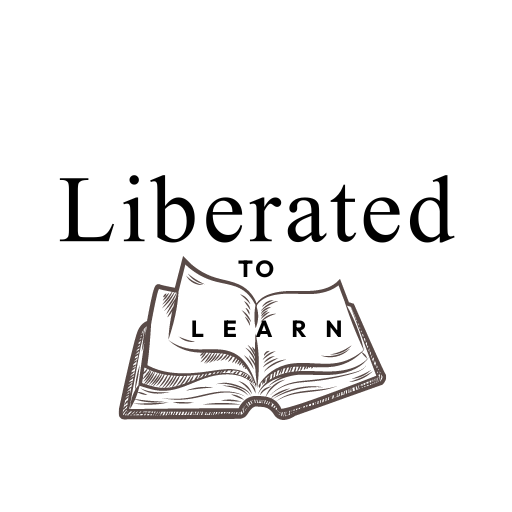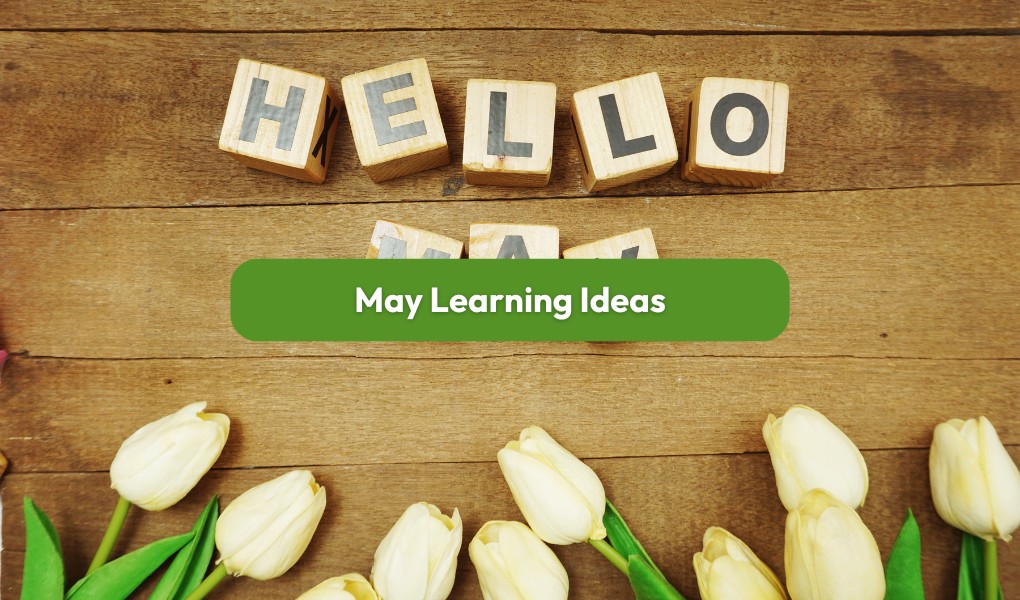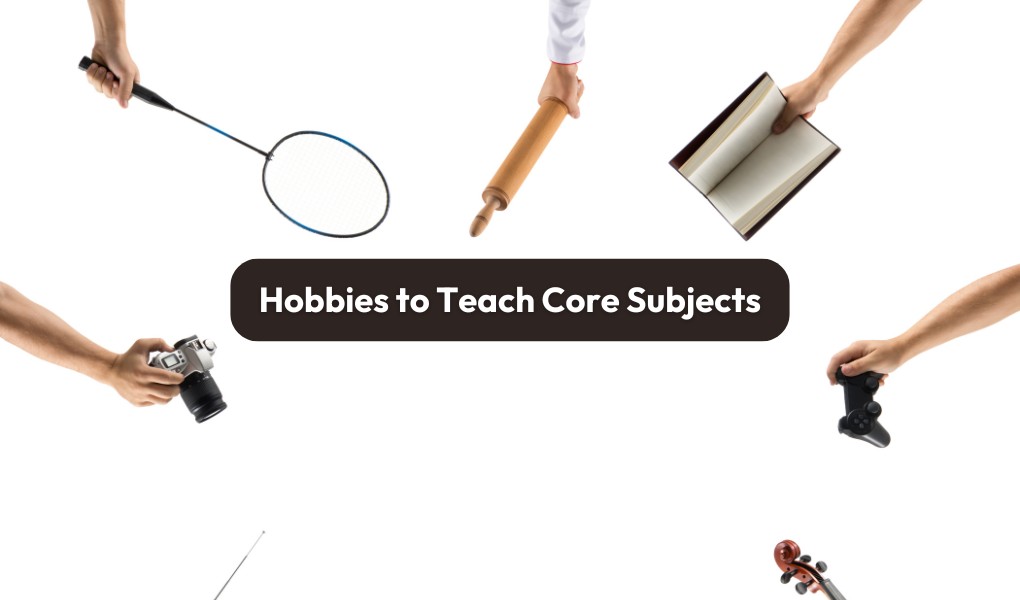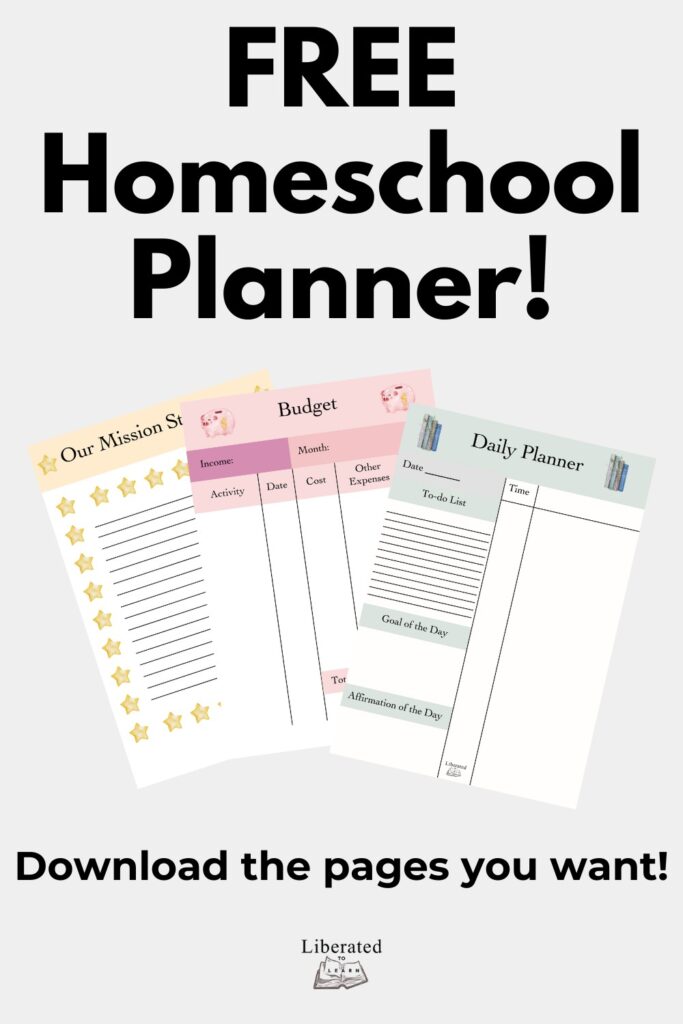We’ve packed this post with fun January homeschool learning ideas and a checklist so you’re free to get creative without having to worry about what you’re going to do each week!
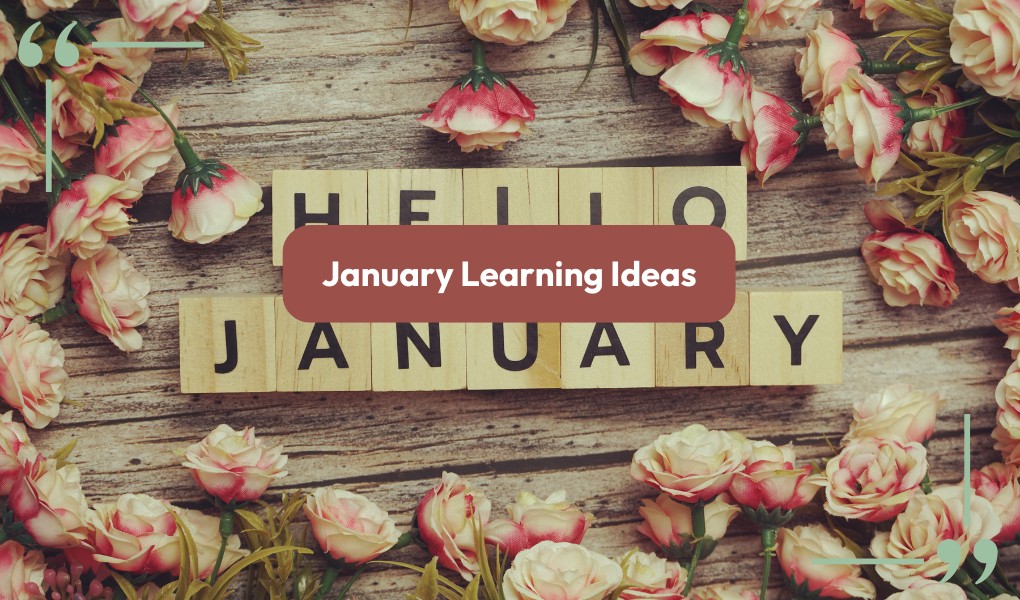
Contents
If you’re homeschooling, January is the perfect month to explore some new learning ideas. With the new year, you can start anew, regardless of whether you’re a new home educator or have been doing it for years.
We’ve packed this post with fun January homeschool learning ideas and a checklist so you’re free to get creative without having to worry about what you’re going to do each week!
And check out our other monthly homeschool learning ideas!
February Homeschool Learning Ideas
March Homeschool Learning Ideas

Why January is Perfect for Homeschool Activities
You can make the most of homeschooling at any time of year, but January definitely has its perks being the first month. It’s a time when we naturally reflect on the year that’s passed and look ahead to the one we’ve just started.
After the buzz of Christmas and the New Year, you may be thinking about making some homeschool resolutions or planning your year of homeschooling, or you may just be going with the flow! However you are deciding to start the year, January is definitely a good time for discovery and exploring new learning ideas.
Let’s dive into some fun homeschool activities and learning themes for January!
January Homeschool Learning Ideas (By Subject)
Winter
Creative ideas:
- Write a story or poem about a snowy winter adventure.
- Write a winter play and act it out.
- Create a winter scrapbook with photos, drawings and things you find outside.
- Paint a winter landscape inspired by a famous artist.
- Make a winter collage.
- Make a snowglobe.
- Watch a winter-themed movie or read a winter-themed book.
- Create a winter journal.
- Write a persuasive essay on “Why winter is the best (or worst) season.”
- Make winter-themed candles.
- Study and listen to classical winter-themed music like Tchaikovsky’s Nutcracker Suite.
- Make your own winter instruments.
- Write lyrics to a winter-inspired song.
- Create your own crossword puzzle using winter vocabulary.
Science ideas:
- Learn about winter weather and how snow and ice form.
- Learn about winter animals’ adaptations.
- Learn about hibernation, migration and animal insulation.
- Grow crystals.
- Make fake snow.
- Do an insulation experiment.
- Learn about constellations visible in January.
- Track the phases of the moon and learn how the earth’s tilt creates seasons.
- Create a mini glacier with layers of sand and ice.
Maths ideas:
- Learn about symmetry by creating paper snowflakes.
- Solve winter maths problems about snow and ice, e.g “if five snowballs melt at the rate of . . . “
- Graph temperature changes throughout January.
- Bake a winter treat and learn about fractions and measurements.
- Calculate the volume of snow to build different-sized igloos.
Geography & History ideas:
- Indigenous culture and how indigenous people thrive in cold climates.
- Learn about the Arctic and the Antarctic. What are their differences?
- Learn about winter festivals and winter solstice traditions around the world.
- Research historical winter events.
- Create a map of places experiencing winter versus summer in January.
- Learn about winter trees and plants.
- Learn about winter inventions, like snow plows.
- Use Google Earth to “visit” famous snowy locations, like the Alps or Antarctica.
Life skill ideas:
- Make hot chocolate or a hearty winter soup.
- Learn how to make a campfire and toast marshmallows.
- Learn how to set up a tent in the garden.
- Make a January budget and track spending throughout the month.
- Learn how to sew, knit or crochet and make a winter item of clothing.
- Cook a winter recipe from another culture.
- Learn about food preservation techniques.
- Create a winter emergency kit and practise packing it.
Outdoor activities:
- Observe winter wildlife and make observations.
- Build a snow fort.
- Create a bird feeder and learn about winter birds.
- Measure icicles.
- Go ice-skating or sledding.
Physical education ideas:
- Try yoga poses inspired by hibernating animals.
- Create an indoor obstacle course leading to a ‘bear’s den’, using pillows and blankets.
- Create your own winter olympics.
- Practice mindfulness with a “snowy forest” guided meditation.
- Try out a winter-themed dance.
The New Year & Goal-Setting
Creative ideas:
- Write your New Year’s or homeschool resolutions.
- List your goals for the month of January.
- Create a dream journal.
- Make a New Year’s vision board.
- Create a resolution jar.
- Decide on a ‘word of the year’ and create a piece of art for it.
- Design a January calendar full of goals.
- Make a time capsule filled with goals, photos and letters, and plan to open it at the end of the year.
- Create firework art.
- Write a New Year’s story.
- Design a New Year’s mask.
- Create a colour wheel of goals for each month.
- Create a goal roadmap.
- Write goals on pieces of paper and fold them into origami.
- Make a New Year’s garland.
- Start a New Year’s scrapbook.
Science ideas:
- Explore the science behind fireworks.
- Do a countdown chemistry experiment.
- Study the mental impact of forming habits and setting goals.
- Make a vision board that lights up by learning how to make a circuit.
- Learn how to track and collect data using scientific methods.
- Design and test paper aeroplanes. Track progress as they improve their designs.
- Learn about the nervous system by measuring reaction times and setting improvement goals.
- Make ice lanterns to study freezing and melting.
Cultural study ideas:
- Host a multicultural New Year’s party.
- Learn about New Year traditions around the world.
- Write your own cultural resolutions.
- Learn about the Chinese Zodiac and create your own.
- Create a cultural ‘good luck’ collage.
- Learn how to say “Happy New Year” in different languages.
- Set goals inspired by other cultures.
- Explore mythology from other countries.
Maths ideas:
- Create a countdown and calculate days, hours and minutes to New Year’s and other big events in January.
- Use fractions and percentages to calculate reaching goals.
- Introduce budgeting for goals throughout January.
- Create a New Year’s resolution pie chart.
- Explore how different countries celebrate New Year’s at different times.
Life skill ideas:
- Design a weekly planner to help with time management.
- Learn to declutter and organise regularly.
- Plan, buy and prepare a meal once a week.
- Write thank you notes to people and learn about the value of gratitude.
- Practise mindfulness and focusing on goals.
- Learn emergency skills like first aid.
- Create problem-solving scenarios and brainstorm solutions.
- Practise role-play scenarios to improve communication.
- Write a family mission statement.
Outdoor ideas:
- Go on a nature walk and reflect on the past year.
- Have a New Year’s picnic and discuss goals together.
- Light a campfire and make wishes for the year.
- Plant a ‘goal tree.’
- Collect smooth stones and paint them with images or words representing goals.
- Go on a walk and photograph things that symbolise your hopes and dreams for the New Year.
- Write positive affirmations on a kite and fly it.
Physical education ideas:
- Set fitness goals for the New Year and track them throughout January.
- Have a New Year’s dance party and practise different styles of dance.
- Create a New Year’s obstacle course with winter-themed obstacles.
- Try out physical activities related to New Year traditions around the world.
- Try a walking challenge and set a goal for steps.
- Blow up balloons and create movement challenges.
- Create a jar of fitness resolutions.
- Do family fitness bingo.
- Journal about mindful movement and achievements made throughout January.

January Homeschool Learning Topics (Checklist)
Creative Writing & Reading
- Write and read about winter myths and legends
- Write a letter from an Antarctic explorer
- Journaling in January
- Famous writers born in January
- Write a winter Haiku
- Winter stories
- Explore the legends of Jack Frost
- Write a winter diary
- Create a winter world
- Write winter poetry and plays
- Write about the Ice Age
- Read The Snow Queen
- Write a winter memory
- Arctic and Antarctic exploration stories
- Write a letter from the North Pole
- Write a story about a January time machine
- Read about survival in winter
- Practise using winter figurative language
- Winter idioms and phrases
Nature & Science
- The tundra ecosystem
- Winter weather
- Arctic and Antarctic exploration
- Ice formations, snowflakes and crystals
- Winter animals and birds
- Evergreens and pine trees
- Hibernation and migration
- Winter night sky: constellations and phases of the moon
- Bears in winter
- Life under the ice
- The northern lights
- Winter gardening
- Snowy landscapes and formations
- Changing seasons
- Physics of ice skating
- Avalanches
- Arctic ocean
- Clouds in winter
- Blizzards and winter storms
- Icebergs
- Penguins and how they care for their young
- Polar bears and their hunting habits
- Snowshoe hares
- Winter-active insects
- Adaptations
- The water cycle
- How animals and humans stay warm
- The magnetic north pole
- The arctic circle
- Permafrost
- Winter monsoons
- Taiga biome
- Ice caves
- Frostbite and hypothermia
- Melting glaciers
History
- Ancient civilisations in winter
- Civil rights movement
- Arctic explorers
- Historical events in January
- Immigration stories
- The Great Blizzard of 1888
- Inuit culture
- Russia’s winter palace
- Journey to the south pole
- The Ice Age
- Vikings and winter survival
- Famous winter wars
- The origin of the name January (Roman roots)
- Famous people who were born in January:
- Isaac Newton (4, January, 1643)
- Joan of Arc (6, January, 1412)
- Paul Revere (1, January, 1735)
- Martin Luther King Jr. (15, January, 1929)
- Stephen Hawking (8, January, 1942)
- Wolfgang Amadeus Mozart (27, January, 1756)
- Medieval winter life
- Industrial Revolution in winter
- History of inventions made in January
Around the World
- Chinese New Year
- Orthodox Christmas
- Australia Day (26 January)
- Scottish history for Burns Night (25 January)
- World Braille Day (4 January)
Maths
- Winter geometry (snowflakes)
- Winter estimation games
- Winter maths equations
- Learn about temperature
- Graph winter weather
- Ratios of hot chocolate
- Winter board games and brain teasers
- Calculating winter daylight hours
- Winter patterns and sequences
- Volumes of snow
Geography
- Snowy landscapes and mountains
- Polar regions
- Winter weather patterns
- Frozen water
- The northern lights
- Icebergs and glaciers
- Animal migration in winter
- Latitude and climate
- Winter in the northern hemisphere vs. the southern hemisphere
- Map the polar circles
- Climate change and melting ice caps
- Snow and water cycle
- Winter energy use
- Winter cities and tourism
- Winter transportation
- The winter solstice
- Time zones in winter
Arts, Music & Crafts
- Winter textures
- Snow globes
- Northern lights art
- Winter wonderlands
- Winter photography
- Ice sculptures
- Snowman portraits
- Winter folklore art
- Snowy owl painting
- Winter tree silhouettes
- Ice lanterns
- Winter scrapbook
- Frosted glass art
- Pinecone bird feeders
- Winter garlands
- Listen to winter-inspired music
- Make a handmade instrument
- Snowy soundscapes
- January composers
Life Skills & Hobbies
- Learn first aid
- Knit and crochet winter clothing
- Practise calligraphy
- Winter woodwork
- Seasonal baking
- Make handmade gifts
- Learn how to keep homes warm in winter
- Make winter meals like soup and casserole
- Learn to budget for winter activities
- Learn about season spices when cooking
- Cook winter meals from around the world
- Set up a tent and camp outside
- Winter nutrition
- Winter survival skills
- Winter safety
Outdoor & Physical Activity
- Winter sports and activities
- Winter yoga poses
- Indoor obstacle course
- Winter scavenger hunt
- Bird watching
- Hike through winter landscapes
- Winter relay race
- Mini winter olympics
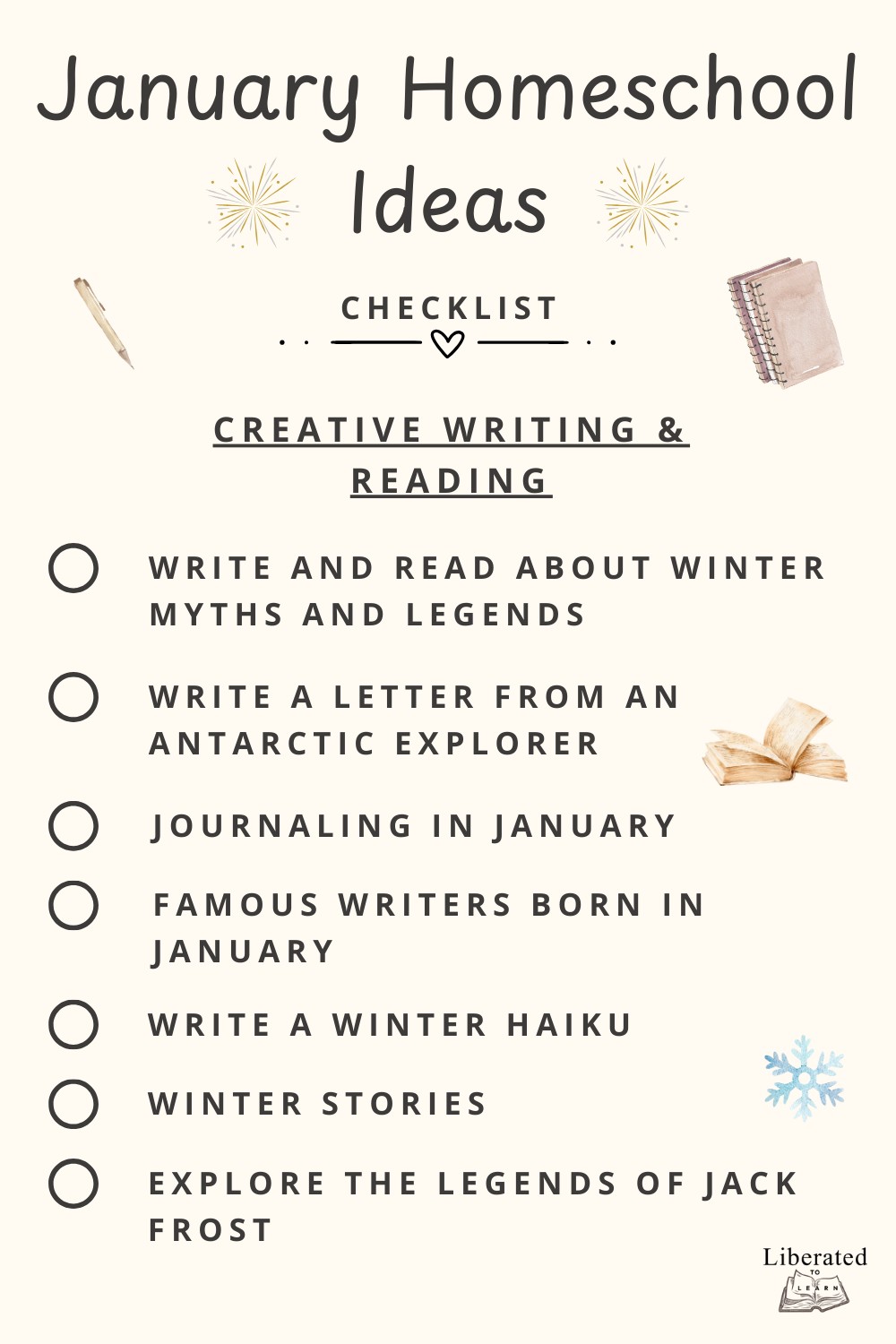
Download the January Homeschool Topics Checklist!
Tips for Homeschooling in January
After the busy holiday period, January is perfect for easing back into homeschooling or starting it for the very first time. Yes, it can be overwhelming when you first get back into it—especially if you’ve had a bit of a break—but fear not! Here are some useful tips to make homeschooling in January a lot easier.
Take it easy
You don’t need to go crazy in the New Year or feel pressured to keep up with your homeschool resolutions. The best thing you can do to help everyone adjust to homeschooling is take it easy. Don’t throw your family into the deep end too soon. Take it slow and try not to do too much all at once.
If motivation is low, start with a bit of encouragement and do activities which your children are really interested in. You don’t have to have it all figured out right away—it can take time to find your feet again, and that’s perfectly normal.
Gradually ease back into a routine
You might be eager to get straight back into a routine if having one works for your family, but just remember, if you’ve had a homeschooling break over Christmas and the New Year, your children might struggle adjusting to a structured schedule again.
Gently easing your family back into a routine will seem less sudden and feel more natural. Starting with a less overwhelming routine will also be more manageable for you, and you can adjust your routine whenever you like, depending on what’s working and what’s not.
Start organising and planning
Most of us tend to feel a whole lot better when we’ve got things planned and organised. Whatever stage you’re at in January, it’s never too late to start organising your homeschool schedule and learning space or planning your homeschool activities and learning ideas.
Even if you’re not the most organised person in the world, a homeschool planner definitely comes in handy, and it’s always up to you how much you do. At the end of the day, you know what you can manage.
Create a cosy learning environment
Unless you’re in the southern hemisphere, January is still all wintry and cosy. And when it’s cold outside, there’s no better place for learning than in an environment which feels all cosy and warm.
If you’re easing into homeschooling throughout January, you might not be doing loads but you’ll definitely have a lot of fun making your homeschool space feel snug and inviting.
Do lots of fun winter activities
If you’re not ready to shake off the buzz of Christmas and the New Year, you can definitely make the most out of homeschooling in January by doing lots of fun winter activities. Who says the fun has to stop? With these ideas from our January homeschool checklist, you’ll not be short on things to do!
Set goals for the year
One of the best things about homeschooling in January is that you can reflect on everything from the previous year and then set new goals to achieve. It’s a great time to look back on what worked and what didn’t, knowing that you’ve now got a fresh year to start anew and dream bigger. You could even create your own home education bucket list for the year!
Have fun and be flexible
More importantly, homeschooling in January should be about having fun! As long as you remain flexible, since we all have our ups and downs, you’ll do just fine! Look out for signs of burnout, adapt and adjust when you need to, and stay positive! Celebrate progress, however small, and know that you’ve got eleven more months to work things out!

m@liberated
Want more from Liberated to Learn?
Subscribe to stay updated about new posts, resources and giveaways!

